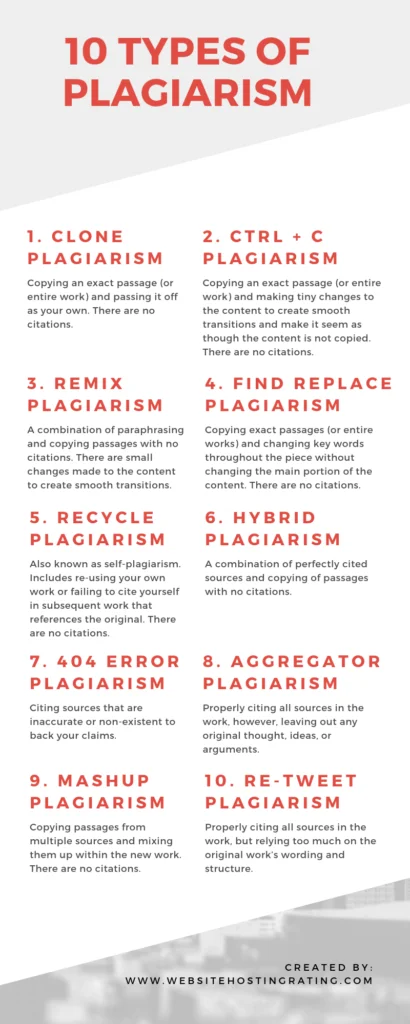Charles Caleb Colton once said, “Imitation is the sincerest form of flattery”. While this sentiment is certainly true, imitation is far from flattery when it comes to copying someone else’s work. Learn what plagiarism is and the different types of plagiarism (with examples) ⇣
By taking the words and ideas of others, whether it be written text, video content, music, or images, and pretending they are your own, is stealing. It’s never okay to copy or plagiarize, the work of others.
How well do you know plagiarism? Take this 8-question quiz to find out!
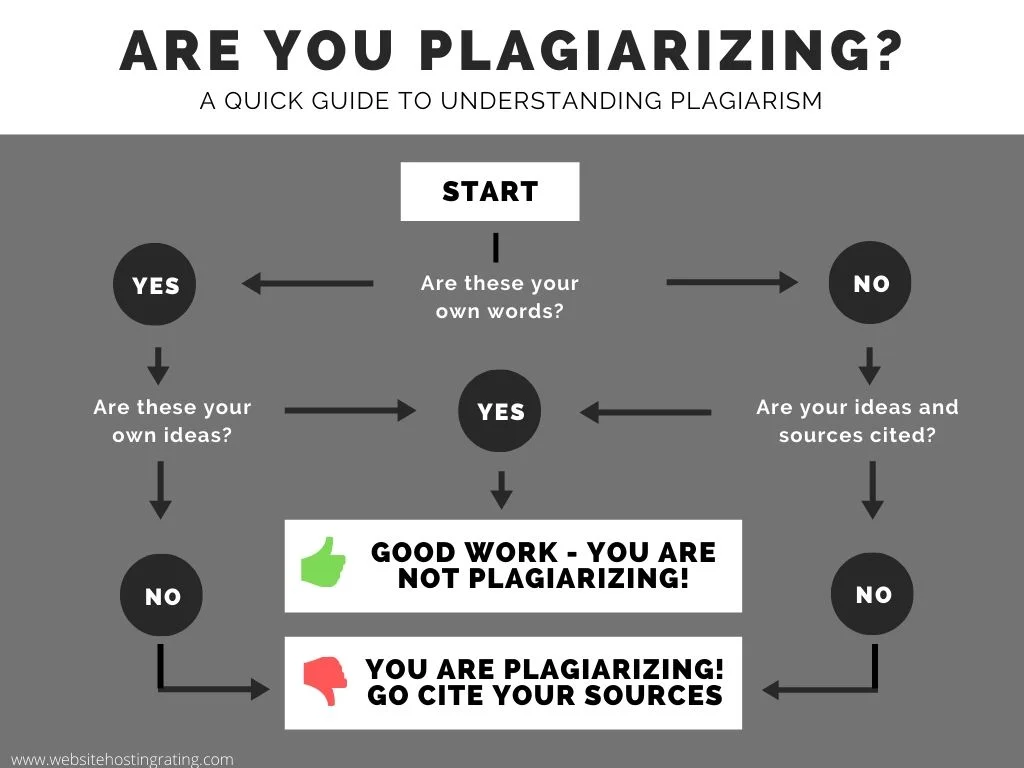
And yet, in a study conducted by the Josephson Institute Center for Youth Ethics, one out of every three high-schoolers surveyed admitted to using the internet to plagiarize an assignment. And things don’t fare better at the university level either.
In a study performed by Donald McCabe, it was discovered that:
- 36% of undergraduates admitted to “paraphrasing/copying few sentences from Internet source without footnoting it.”
- 7% reported copying work “almost word for word from a written source without citation.”
- 3% of students admitted to getting their papers from a term paper mill.
Shocking right?
Using another person’s words, ideas, information, or creative work (such as art, music, or photography) is allowed, but only if you acknowledge the original author and give credit where credit is due. If you don’t, you’re plagiarizing their work.
Unfortunately, many people don’t understand the seriousness of copying the work of others.
That’s why today we’re going to take a closer look at what plagiarism is, the different types of plagiarism, and the consequences you face if you commit plagiarism.
What is plagiarism? – definition and examples
According to the Merriam Webster dictionary, to plagiarize means to:
- Steal and pass off (the ideas or words of another) as one’s own
- Use (another’s production) without crediting the source
- Commit literary theft
- Present as new and original an idea or product derived from an existing source
That said, plagiarism is a complex concept that expands beyond simply taking someone’s work and passing it off as your own.
Plagiarism vs copyright infringement vs trademark violation
Though different, the terms plagiarism, copyright infringement, and trademark violation are often used interchangeably. However, each have their own distinct meanings and applications:
Plagiarism

Plagiarism is using someone else’s work or ideas without attributing proper credit and presenting the work or ideas as your own. It is considered an academic violation, though it is not illegal in a criminal or civil sense. When someone commits plagiarism, the act is against the author of the work.
Some examples of plagiarism include:
- Creating false citations to ‘credit’ ideas that are not your own
- Quoting the words of someone without acknowledging them
- Copying or buying a research/term paper and turning it in as your own
- Using the exact words of someone else in your own work without citing the source or crediting the author
- Paraphrasing or restructuring ideas while relying too heavily on the author’s original work
Copyright infringement

Copyright infringement happens when someone uses a copyrighted work and reproduces, distributes, performs, or publicly displays the work without the permission of the copyright owner.
Copyrights give people an easy way to inform the public that the work is theirs and receive proper recognition when it’s used.
Copyrighted work usually has a copyright notice placed on it, though it’s not required. It is the responsibility of others to research the work they’re using to ensure there are no copyrights attached to it.
Here are the most common types of works with copyrights:
- Literature
- Music
- Audio-visuals
- Sound recordings
- Art
- Architectural plans and drawings
One of the most obvious examples of copyright infringement is the use of music in video content that you don’t have permission to use. If you’re interested in reading about a famous copyright infringement case, check out the case of Napster versus various recording companies.
Trademark violation
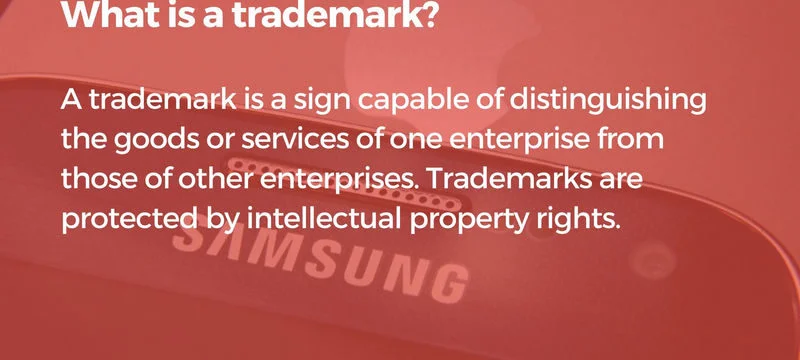
Unlike copyright, which protects primarily literary and artistic works, a trademark protects works such as names, symbols, colors, and sounds of goods and services. They give companies a way to protect things that help “brand a business” and build recognition amongst customers.
For example, the popular Acme Publishing Company would copyright books and movies it created but trademark the company name and logo.
Other works protected by trademarking include:
- Titles, slogans, and taglines
- Procedures and methods
- Ingredient lists
- Familiar symbols, such as a “No Smoking” sign
One easy to understand example of a trademark infringement involved Apple Corps (a music company started by the Beatles) and Apple Inc. (a tech company founded by Steve Jobs).
Common types of plagiarism (10 examples of plagiarism)
In an attempt to clarify plagiarism for both educators and students, Turnitin performed a worldwide survey of nearly 900 secondary and higher education instructors to identify the most common forms of plagiarism and place them on what has been termed the Plagiarism Spectrum.
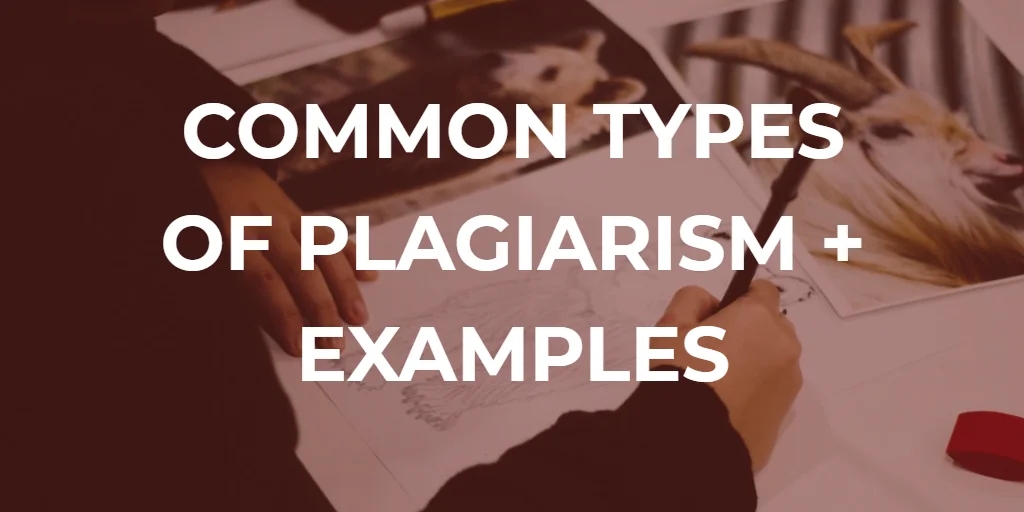
Here we’ll look at the Plagiarism Spectrum and provide examples for clarity using a simple passage about elephants, found in The Columbia Encyclopedia, 6th edition.
- Clone plagiarism
- CTRL + C plagiarism
- Remix plagiarism
- Find and replace plagiarism
- Recycle plagiarism
- Hybrid plagiarism
- 404 error plagiarism
- Aggregator plagiarism
- Mashup plagiarism
- Re-tweet plagiarism
1. Clone plagiarism
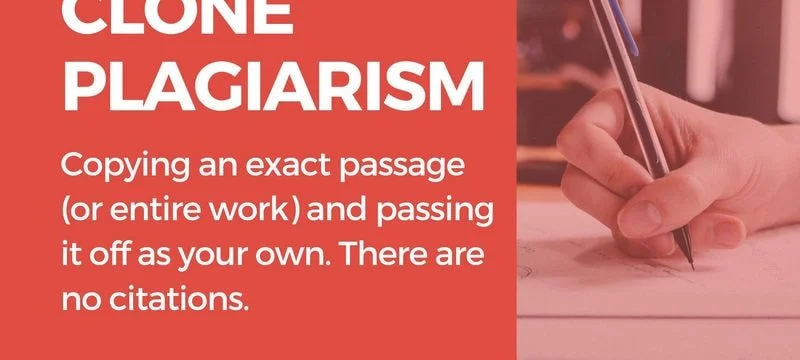
Clone plagiarism is the act of taking someone else’s work, word-for-word, and submitting it as your own. This is often seen in schoolwork submitted by students or on websites that scrape content from reputable websites and paste it on their own site as though it were their own writing.
Example of clone plagiarism:
| Original Source | Writer’s Work |
| Elephants are browsing animals, feeding on fruits, leaves, shoots, and tall grasses; they consume hundreds of pounds of food a day and drink up to 50 gal (190 liters) of water. They have no fixed living place, but travel about in herds of up to 100 animals, led by a young, strong male and including young bulls (males), cows (females), and calves. Old males are generally solitary or live in small groups. | Elephants are browsing animals, feeding on fruits, leaves, shoots, and tall grasses; they consume hundreds of pounds of food a day and drink up to 50 gal (190 liters) of water. They have no fixed living place, but travel about in herds of up to 100 animals, led by a young, strong male and including young bulls (males), cows (females), and calves. Old males are generally solitary or live in small groups. |
The writer has taken a passage from the original work, cut and paste it word-for-word, and made it seem as though it was their own.
2. CTRL + C plagiarism
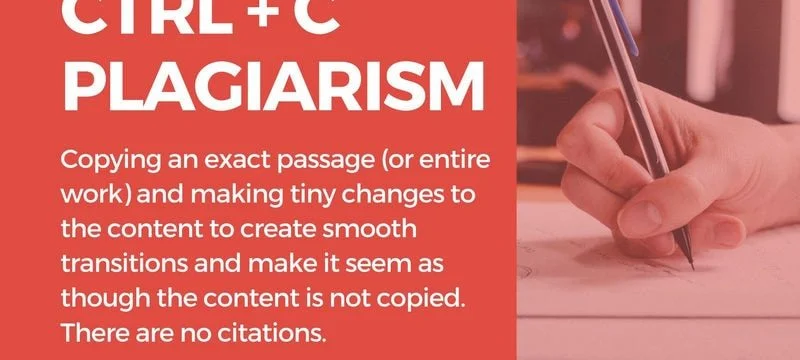
CTRL + C plagiarism much like clone plagiarism, though there are some small changes to the content. Most of the work, however, is cut and pasted and appears to be the work of the writer.
Example of CTRL + C plagiarism:
| Original Source | Writer’s Work |
| Elephants are browsing animals, feeding on fruits, leaves, shoots, and tall grasses; they consume hundreds of pounds of food a day and drink up to 50 gal (190 liters) of water. They have no fixed living place, but travel about in herds of up to 100 animals, led by a young, strong male and including young bulls (males), cows (females), and calves. Old males are generally solitary or live in small groups. | Elephants are browsing animals that feed on fruits, leaves, shoots, and tall grasses. They consume hundreds of pounds of food a day and drink up to 50 gal of water. Elephants have no fixed living place, but travel about in herds of up to 100 animals. They are led by a young, strong male. In addition, young bulls (males), cows (females), and calves are part of the group. Old males are generally solitary or live in small groups. |
Notice how the majority of the writer’s passage is a word-for-word copy of the original source, with small transition changes.
3. Remix plagiarism
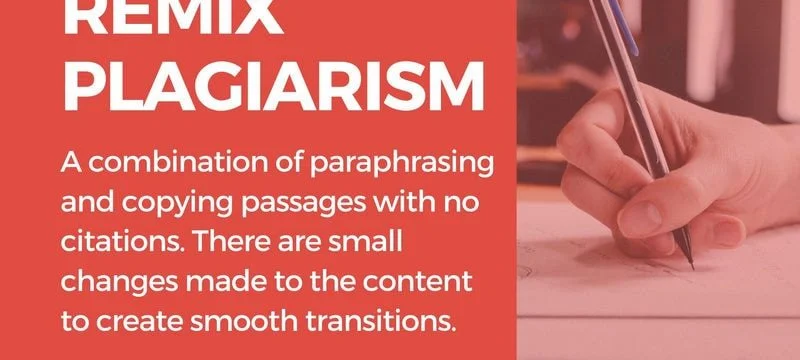
Remix plagiarism is the act of collecting information from multiple sources, combining into one work by paraphrasing, and then claiming it as your own work. This is considered plagiarism when there are no citations stating the sources of the information.
Example of remix plagiarism:
| Original Source(s) | Writer’s Work |
| Elephants are browsing animals, feeding on fruits, leaves, shoots, and tall grasses; they consume hundreds of pounds of food a day and drink up to 50 gal (190 liters) of water. They have no fixed living place, but travel about in herds of up to 100 animals, led by a young, strong male and including young bulls (males), cows (females), and calves. Old males are generally solitary or live in small groups. (Source)
The largest land mammal on earth, the African elephant weighs up to eight tons. The elephant is distinguished by its massive body, large ears and a long trunk, which has many uses ranging from using it as a hand to pick up objects, as a horn to trumpet warnings, an arm raised in greeting to a hose for drinking water or bathing. (Source) | African elephants, the largest land mammal on earth, weigh up to eight tons. Elephants have a massive body, large ears, and a long trunk. One reason elephants are so big is that they consume hundreds of pounds of food a day and drink up to 50 gal (190 liters) of water. Elephants have no fixed living place, but travel about in herds of up to 100 animals, led by a young, strong male. Old male elephants usually live alone or in small groups. |
With remix plagiarism, there is a mixture of clone plagiarism and CTRL + C plagiarism. Some phrases are copied word-for-word while others are paraphrased and have transitions to make the text flow. The key here is, however, that there is not a single source citation.
4. Find and replace plagiarism
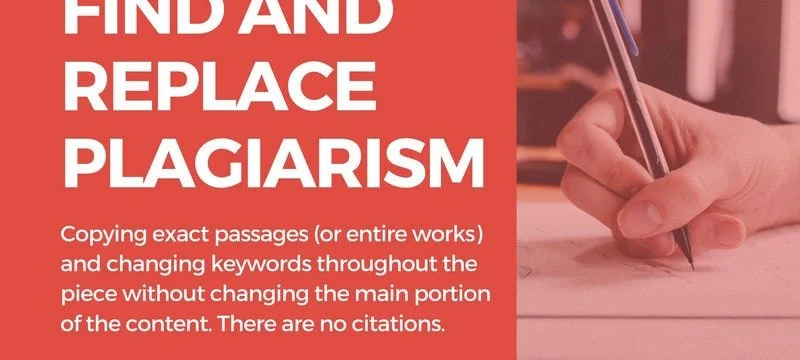
Find and replace plagiarism involves changing keywords and phrases of the original content, but keeping the main parts of the original source intact. This type of plagiarism is very close to both clone and CTRL + C plagiarism.
Example of find and replace plagiarism:
| Original Source | Writer’s Work |
| Elephants are browsing animals, feeding on fruits, leaves, shoots, and tall grasses; they consume hundreds of pounds of food a day and drink up to 50 gal (190 liters) of water. They have no fixed living place, but travel about in herds of up to 100 animals, led by a young, strong male and including young bulls (males), cows (females), and calves. Old males are generally solitary or live in small groups. | Elephants are non-stationary animals, eating fruits, leaves, shoots, and tall grasses. They eat hundreds of pounds of food a day and drink up to 50 gallons of water. They don’t live in one place, but travel in herds of up to 100 animals, led by a young, strong male and including young bulls (males), cows (females), and calves. Old males are generally alone or live in small groups. |
Here, the writer changes some of the keyword and phrases, without changing the main content. Again, there are no sources to cite where the information originated.
5. Recycle plagiarism
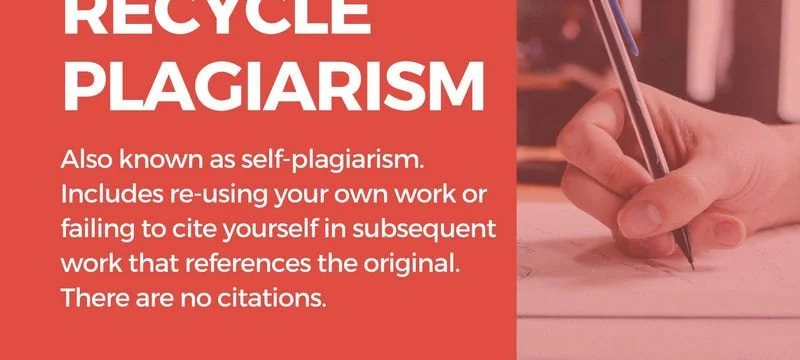
Also known as self-plagiarism, recycle plagiarism is borrowing from one’s own previous work without properly citing the sources. It is not usually intentional, though there are some instances where it is.
For example, using the same term paper for two different classes is considered plagiarism. Even if the first paper you turned in was original (not plagiarized), the minute you turned the same paper in the second time, it is considered plagiarism because that work is no longer considered original.
Example(s) of recycle plagiarism:
- Turning in a paper that you previously turned in to another class
- Using the same data from a previous study for a new one
- Submitting a piece for publication knowing it contains work that has already been shared or published
- Using old papers in new ones without citing yourself
This is not the most serious form of plagiarism you can commit. However, many universities look down upon reusing work and can result in a failing grade, suspension, or even expulsion. When it comes to the internet, publishing duplicate content on multiple websites is not only self-plagiarism; it hurts your overall SEO efforts and can lead to lower search rankings.
6. Hybrid plagiarism
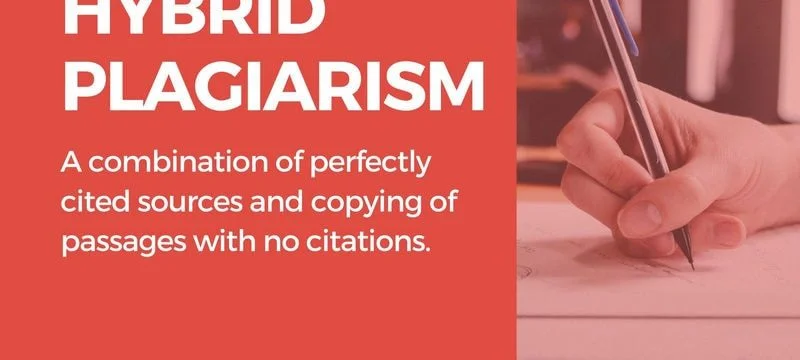
Hybrid plagiarism is a blend of work that is properly cited alongside copied passages from an original source that is not cited. This type of work gives off the essence that it is not plagiarized, thanks to the few citations, but still contains clone plagiarism.
Example of hybrid plagiarism:
| Original Source | Writer’s Work |
| Elephants are browsing animals, feeding on fruits, leaves, shoots, and tall grasses; they consume hundreds of pounds of food a day and drink up to 50 gal (190 liters) of water. They have no fixed living place, but travel about in herds of up to 100 animals, led by a young, strong male and including young bulls (males), cows (females), and calves. Old males are generally solitary or live in small groups. | Elephants are browsing animals, feeding on fruits, leaves, shoots, and tall grasses; they consume hundreds of pounds of food a day and drink up to 50 gal (190 liters) of water. “As a result, these large mammals place great demands on the environment and often come into conflict with people in competition for resources. ¹ They have no fixed living place, but travel about in herds of up to 100 animals, led by a young, strong male and including young bulls (males), cows (females), and calves. Old males are generally solitary or live in small groups. ¹ “Facts” World Wildlife Fund. WWF. 11 Sep. 2019. <https://www.worldwildlife.org/species/elephant> |
As you can see, there is one instance where the writer properly cited the source of information. However, unbeknownst to the reader, the rest of the passage is clone plagiarism.
7. 404 error plagiarism
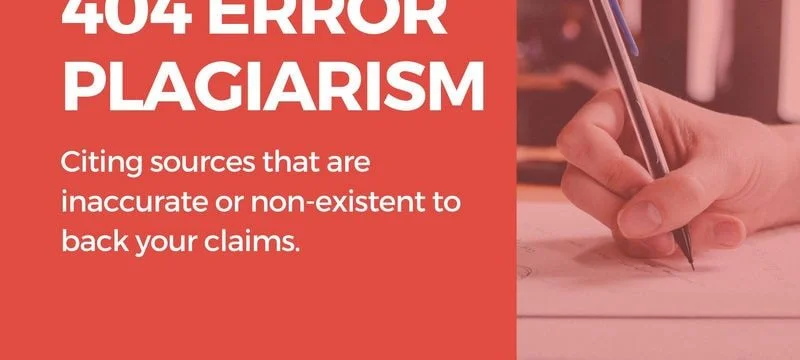
404 error plagiarism applies to both physical sources of information and sources found on the internet. When you commit 404 error plagiarism, you are citing a non-existent source or are providing inaccurate source information. This is often done to add proof to an academic paper without having actual source information to back it up. It gives the false pretense that the information you’re providing is real and true.
Example of 404 error plagiarism:
| Original Source | Writer’s Work |
| Elephants are browsing animals, feeding on fruits, leaves, shoots, and tall grasses; they consume hundreds of pounds of food a day and drink up to 50 gal (190 liters) of water. They have no fixed living place, but travel about in herds of up to 100 animals, led by a young, strong male and including young bulls (males), cows (females), and calves. Old males are generally solitary or live in small groups. | “Elephants are browsing animals, feeding on fruits, leaves, shoots, and tall grasses; they consume hundreds of pounds of food a day and drink up to 50 gal (190 liters) of water.” ¹ Contrary to what people believe, elephants do not eat meat. Despite their size, they are rather docile unless provoked and are happy to eat their plants and fruit in peace. “Because elephants are so huge, however, they can crush a car or even a small home.” ² “As a result, these large mammals place great demands on the environment and often come into conflict with people in competition for resources.” ³ ¹ “Elephant” Encyclopedia.com. The Colombia Encyclopedia, 6th edition. 11 Sep. 2019. <https://www.encyclopedia.com/plants-and-animals/animals/vertebrate-zoology/elephant> ² “Elephants in the Wild” Cool Elephant Facts. My Elephant Website. 11, Sep. 2019. <https://thissourcedoesntexist.com> ³ “Facts” World Wildlife Fund. WWF. 11 Sep. 2019. <https://www.worldwildlife.org/species/elephant> |
Here the example shows that if a reader were to click on the provided source that is non-existent, they would get a 404 error on the screen. The same can be done using fake publications.
8. Aggregator plagiarism
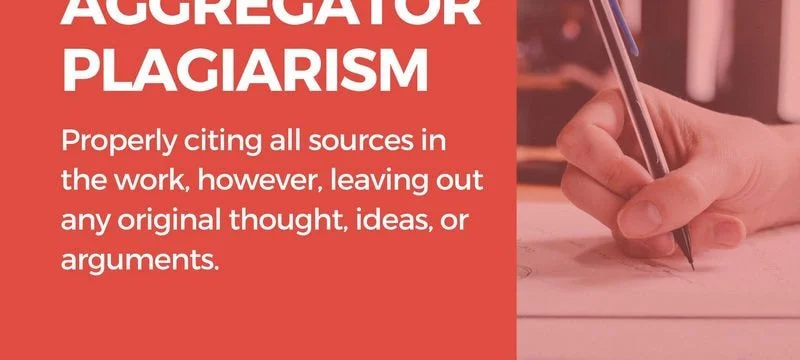
Aggregator plagiarism involves properly citing sources. The catch is there is very little original work in the piece, meaning the writer simply cut and paste whole passages from sources, cited them, and turned in or published the work under their own name.
Example of aggregator plagiarism:
| Original Source | Writer’s Work |
| Elephants are browsing animals, feeding on fruits, leaves, shoots, and tall grasses; they consume hundreds of pounds of food a day and drink up to 50 gal (190 liters) of water. They have no fixed living place, but travel about in herds of up to 100 animals, led by a young, strong male and including young bulls (males), cows (females), and calves. Old males are generally solitary or live in small groups. | “Elephants are browsing animals, feeding on fruits, leaves, shoots, and tall grasses; they consume hundreds of pounds of food a day and drink up to 50 gal (190 liters) of water.” ¹ “As a result, these large mammals place great demands on the environment and often come into conflict with people in competition for resources.” ² ¹ “Elephant” Encyclopedia.com. The Columbia Encyclopedia, 6th edition. 11 Sep. 2019. <https://www.encyclopedia.com/plants-and-animals/animals/vertebrate-zoology/elephant> ² “Facts” World Wildlife Fund. WWF. 11 Sep. 2019. <https://www.worldwildlife.org/species/elephant> |
In this example of plagiarism, there are no transitions, no original thoughts, and no new information from the writer. There are only facts copied and pasted into a document.
9. Mashup plagiarism
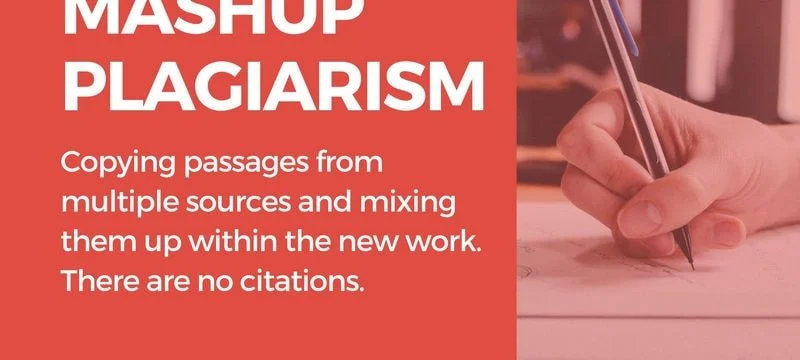
Mashup plagiarism is the act of mixing up copied information from multiple sources to create what you feel is a new and original work, despite the fact that there are no original thoughts. There are also no citations, which makes this a serious form of plagiarism.
Example of mashup plagiarism:
| Original Source(s) | Writer’s Work |
| Elephants are browsing animals, feeding on fruits, leaves, shoots, and tall grasses; they consume hundreds of pounds of food a day and drink up to 50 gal (190 liters) of water. They have no fixed living place, but travel about in herds of up to 100 animals, led by a young, strong male and including young bulls (males), cows (females), and calves. Old males are generally solitary or live in small groups. (Source)
The largest land mammal on earth, the African elephant weighs up to eight tons. The elephant is distinguished by its massive body, large ears and a long trunk, which has many uses ranging from using it as a hand to pick up objects, as a horn to trumpet warnings, an arm raised in greeting to a hose for drinking water or bathing. (Source) | Elephants are browsing animals, feeding on fruits, leaves, shoots, and tall grasses. The largest land mammal on earth, the African elephant weighs up to eight tons. They consume hundreds of pounds of food a day and drink up to 50 gal (190 liters) of water. The elephant is distinguished by its massive body, large ears and a long trunk, which has many uses ranging from using it as a hand to pick up objects, as a horn to trumpet warnings, an arm raised in greeting to a hose for drinking water or bathing. |
If you read the two original sources, and then the writer’s work, you’ll see the copy and paste sections of each original work ‘mashed up’ to make what seems like new work. However, there are no source citations or original thought making this document the writer’s own work.
10. Re-tweet plagiarism
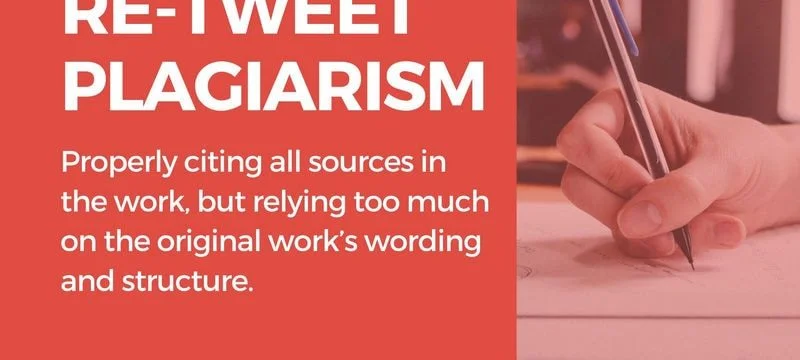
Re-Tweet plagiarism includes proper citations but relies heavily on the original work when it comes to structure and wording, and lacks original thought, ideas, or arguments.
Example of re-tweet plagiarism:
| Original Source(s) | Writer’s Work |
| Elephants are browsing animals, feeding on fruits, leaves, shoots, and tall grasses; they consume hundreds of pounds of food a day and drink up to 50 gal (190 liters) of water. They have no fixed living place, but travel about in herds of up to 100 animals, led by a young, strong male and including young bulls (males), cows (females), and calves. Old males are generally solitary or live in small groups. | Elephants are known for being browsing animals, feeding on fruits, leaves, shoots, and tall grasses. They eat hundreds of pounds of food a day and drink up to 50 gallon of water too. Elephants have no fixed living place, but travel in groups of up to 100 animals. They are led by a young, strong male and the group includes young bulls (males), cows (females), and calves. Old males are generally solitary or live in small groups. ¹ ¹ “Elephant” Encyclopedia.com. The Columbia Encyclopedia, 6th edition. 11 Sep. 2019. <https://www.encyclopedia.com/plants-and-animals/animals/vertebrate-zoology/elephant> |
Here, the writer does cite the sources, which is great. But rather than copy the passage word-for-word and quote the original author, the writer makes it seem as though only a few thoughts are from the source and the rest is original.
It might seem at first glance that many of these common forms of plagiarism are the same. But when you look closer, it’s the tiny details such as citing with no original thought, only using transitional words, or simply cutting and pasting whole passages that set each type of plagiarism apart.
Common forms of plagiarism summary (and an infographic)
Here’s a brief summary of the most common types of plagiarism:
- Clone plagiarism: Copying an exact passage (or entire work) and passing it off as your own. There are no citations.
- CTRL +C plagiarism: Copying an exact passage (or entire work) and making tiny changes to the content to create smooth transitions and make it seem as though the content is not copied. There are no citations.
- Remix plagiarism: A combination of paraphrasing and copying passages with no citations. There are small changes made to the content to create smooth transitions.
- Find and Replace plagiarism: Copying exact passages (or entire works) and changing keywords throughout the piece without changing the main portion of the content. There are no citations.
- Recycle plagiarism: Also known as self-plagiarism. Includes re-using your own work or failing to cite yourself in subsequent work that references the original. There are no citations.
- Hybrid plagiarism: A combination of perfectly cited sources and copying of passages with no citations.
- 404 Error plagiarism: Citing sources that are inaccurate or non-existent to back your claims.
- Aggregator plagiarism: Properly citing all sources in the work, however, leaving out any original thought, ideas, or arguments.
- Mashup plagiarism: Copying passages from multiple sources and mixing them up within the new work. There are no citations.
- Re-Tweet plagiarism: Properly citing all sources in the work, but relying too much on the original work’s wording and structure.
and here is an infographic you are free to use:
The consequences of plagiarism (real-life examples)
Although plagiarism in any form is not considered illegal, you face consequences if caught plagiarizing the work of another. The severity of those consequences will depend on the seriousness of the type of plagiarism you commit.
Here’s a look at some real-life examples of how plagiarism can affect your life:
- Former Vice President of the United States of America, Joe Biden, failed a course in law school for using “five pages from a published law review article without quotation or attribution” in an article he wrote for the Fordham Law Review. Most notably, however, Biden had to withdraw from the presidential race in 1988 for plagiarizing speeches made by the Kennedys, Hubert Humphrey, and Britain’s Neil Kinnock.
- Harold Courlander accused Alex Haley, best known for his book Roots (which was turned into a well-known multi-series and resulted in a Pulitzer Prize for Haley), of using parts of his book The African. Courlander sued Haley and Haley eventually admitted to plagiarism, which tarnished his reputation and cost him what was presumed to be hundreds of thousands of dollars in an undisclosed settlement.
- Kaavya Viswanathan, an up and coming writer from Harvard University, ruined her own career before it could reach its potential when she plagiarized parts of her first novel How Opal Mehta Got Kissed, Got Wild and Got a Life. Afterwards word got out that she had committed plagiarism, her published refused to release the second novel.
- Allison Routman of Ohio University was caught plagiarizing Wikipedia in an essay she submitted for a chance to partake in a Semester at Sea. As per university rules, she was expelled from the school. The worst part of it all was that she was already at sea (in Greece) when she was expelled and had to find her own way back home.
- Even as recently as 2018, reputable newspaper reporter Anne Blythe lost her job as a result of failing to credit sources and characters in her stories.
These are just some of the examples of plagiarism in the real world, and how it doesn’t just affect students, but creators of all kinds. In the end, plagiarism is serious and it’s best to avoid it all costs. Put simply, just cite your sources and cover your bases.
Online plagiarism detection tools
There are a wide range of helpful tools on the Internet that can detect if essays, documents, and papers have been plagiarized. Here are some of the best ones:
- Plagium is a basic but powerful free plagiarism detection tool where you can upload 5,000 characters of text and compare the text against other uploaded files, to perform a quick scan or a deep search.
- Grammarly is an easy-to-use premium plagiarism checker that can detect plagiarism from billions of web pages on the Internet as well as check against the ProQuest academic database
- Dupli Checker is free and easy to use plagiarism checker tool. You can either copy and paste the text, or upload a file from your computer to check for plagiarism. Dupli Checker allows you to do 50 free checks per day.
- Plagiarisma is another free and simple to use online tool that also comes as a Firefox and Google Chrome browser extension. You can either copy and paste the text, or upload a file from your computer to check for plagiarism.
How to cite sources
You
shouldmust always cite the sources of information you use in your academic work because it’s an ethical requirement and it makes your work more credible, and it tells your readers where you found your information.
The three most commonly used style guides in academia for citing sources are the APA Style, MLA Style, and Chicago Style..
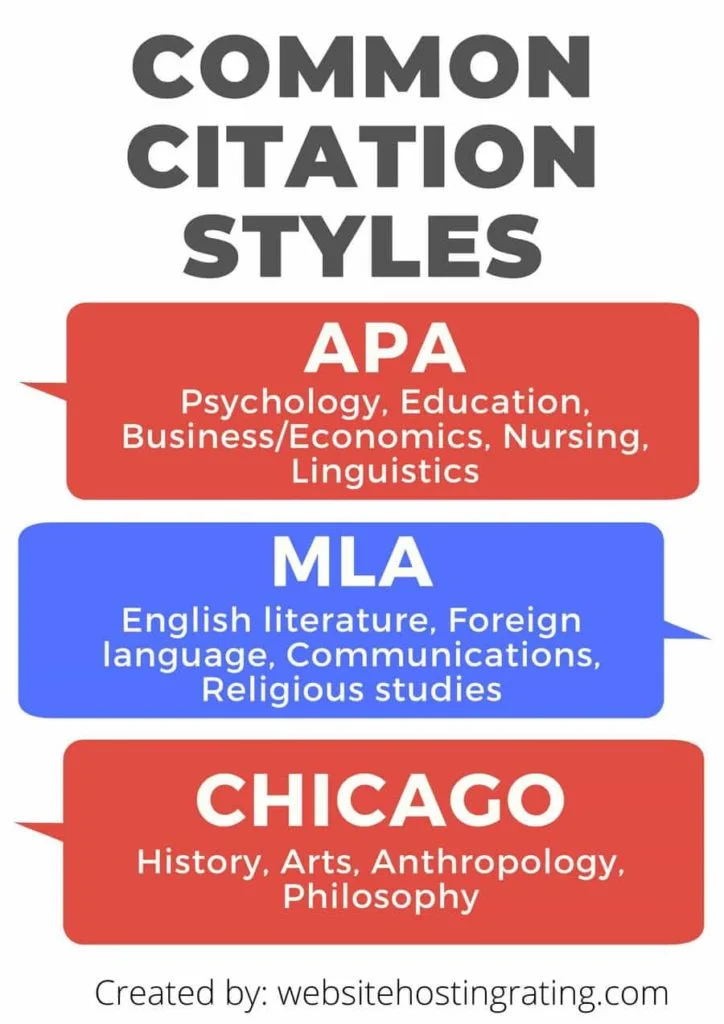
First, you need to determine what citation style you need to use. There are many different citation styles used in different areas of academia. You should ask your supervisor which style to use for your work.
The most common styles used in academic writing are the Modern Language Association (MLA), American Psychological Association (APA), and Chicago (A and B).
- American Psychological Association — APA Style
- Chicago Manual of Style Online
- Modern Language Association — MLA Style
Plagiarism Quiz ⏳
How well do you know plagiarism? Take this quick 8-question plagiarism quiz to find out!
Final thoughts
So, just to quickly recap:
Trust me, citing your sources and giving recognition to others and their hard work is flattering enough.

